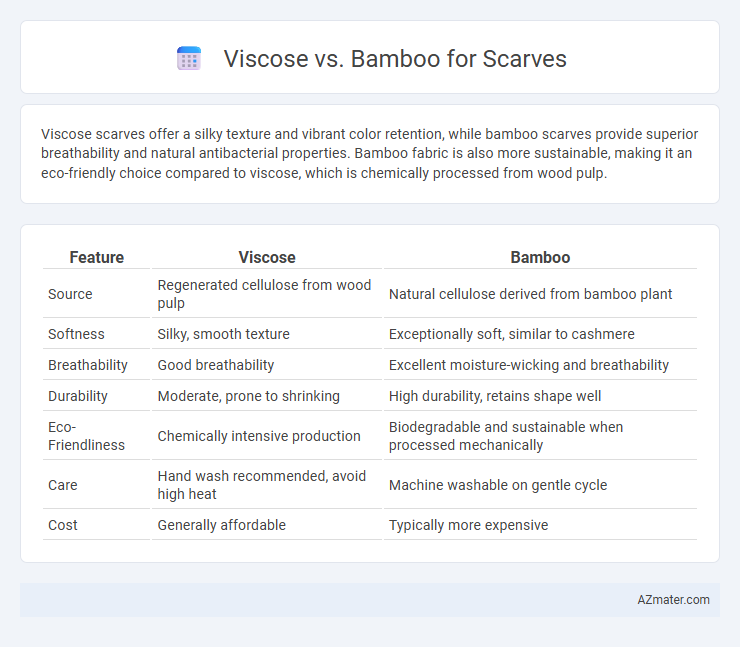Viscose scarves offer a silky texture and vibrant color retention, while bamboo scarves provide superior breathability and natural antibacterial properties. Bamboo fabric is also more sustainable, making it an eco-friendly choice compared to viscose, which is chemically processed from wood pulp.
Table of Comparison
| Feature | Viscose | Bamboo |
|---|---|---|
| Source | Regenerated cellulose from wood pulp | Natural cellulose derived from bamboo plant |
| Softness | Silky, smooth texture | Exceptionally soft, similar to cashmere |
| Breathability | Good breathability | Excellent moisture-wicking and breathability |
| Durability | Moderate, prone to shrinking | High durability, retains shape well |
| Eco-Friendliness | Chemically intensive production | Biodegradable and sustainable when processed mechanically |
| Care | Hand wash recommended, avoid high heat | Machine washable on gentle cycle |
| Cost | Generally affordable | Typically more expensive |
Introduction to Viscose and Bamboo Scarves
Viscose scarves are crafted from regenerated cellulose fibers, offering a soft texture, vibrant color retention, and excellent breathability, making them a popular choice for stylish and comfortable accessories. Bamboo scarves are derived from bamboo pulp through a similar viscose process but are often praised for their eco-friendliness, natural antibacterial properties, and superior moisture-wicking abilities. Both materials provide lightweight drape and smooth finishes, catering to diverse preferences in sustainable and fashionable scarf options.
Understanding Viscose Fabric
Viscose fabric, often used in scarves, is a semi-synthetic fiber made from regenerated cellulose derived from wood pulp, offering a soft, breathable, and lightweight texture ideal for comfort and draping. Compared to bamboo fabric, viscose provides similar smoothness but tends to have a more lustrous finish and higher absorbency, making it suitable for dyeing vibrant colors. Understanding viscose's eco-impact involves recognizing its chemical-intensive production process, which contrasts with bamboo's more sustainable mechanical extraction methods.
What is Bamboo Fabric?
Bamboo fabric is a sustainable textile made from bamboo pulp, known for its softness, breathability, and natural antibacterial properties, making it ideal for scarves. Unlike viscose, which is a semi-synthetic fiber derived from wood pulp through intensive chemical processing, bamboo fabric often involves a more eco-friendly production method, preserving its natural moisture-wicking and hypoallergenic qualities. This makes bamboo scarves comfortable for sensitive skin and suitable for year-round wear, combining luxury with environmental benefits.
Key Differences Between Viscose and Bamboo
Viscose and bamboo both offer soft, breathable fabric options for scarves, but they differ significantly in source and processing. Viscose is a semi-synthetic fiber derived from wood pulp, often involving chemical treatments that impact environmental sustainability, while bamboo fabric is touted for its natural antibacterials and eco-friendliness due to minimal chemical use. In terms of texture, bamboo scarves are generally smoother and more moisture-wicking compared to viscose, which may feel slightly heavier and less durable over time.
Softness and Comfort Comparison
Viscose scarves offer a silky-smooth texture that drapes elegantly while providing excellent breathability and moisture absorption, enhancing overall comfort. Bamboo fabric, renowned for its natural hypoallergenic and antibacterial properties, delivers a softer, more plush feel ideal for sensitive skin in scarves. The superior softness of bamboo combined with its moisture-wicking capabilities makes it a preferred choice for scarf comfort compared to traditional viscose.
Breathability and Moisture-Wicking Properties
Viscose scarves offer moderate breathability and moisture-wicking capabilities due to their semi-synthetic nature derived from wood pulp, allowing some airflow but potentially retaining moisture longer than bamboo. Bamboo scarves excel in breathability and moisture management, featuring natural antibacterial properties and superior fiber structure that quickly wick sweat away from the skin, keeping the wearer cooler and drier. Choosing bamboo over viscose enhances comfort in warm conditions through optimized airflow and efficient moisture evaporation.
Sustainability and Eco-Friendliness
Viscose production involves chemical-intensive processes that can contribute to environmental pollution, while bamboo fabric, when sourced from certified sustainable plantations, offers a more eco-friendly alternative due to its rapid growth and low water requirements. However, bamboo fibers are often processed into viscose or rayon using similar chemical treatments, which can diminish its sustainability benefits if not managed responsibly. Choosing scarves made from bamboo lyocell or mechanically processed bamboo ensures greater environmental friendliness compared to conventional viscose.
Durability and Care Requirements
Viscose scarves offer moderate durability but tend to weaken when wet, requiring gentle hand washing and air drying to maintain their shape. Bamboo scarves are known for superior durability due to their natural strength and antimicrobial properties, allowing for easier machine washing on delicate cycles. Both materials benefit from avoiding high heat during drying to preserve fiber integrity and prolong scarf lifespan.
Price and Value for Money
Viscose scarves generally offer a lower price point compared to bamboo scarves, making them a budget-friendly option for stylish accessories. Bamboo scarves, while often more expensive, provide superior breathability, softness, and eco-friendly attributes, enhancing their value for money. Choosing bamboo can be a worthwhile investment for those prioritizing sustainability and long-term comfort.
Which is Better for Scarves: Viscose or Bamboo?
Bamboo fiber scarves offer superior breathability and natural antibacterial properties, making them ideal for sensitive skin and all-season wear. Viscose, derived from wood pulp, provides a smooth, silk-like finish with excellent drapability but may lack the eco-friendly benefits and moisture-wicking abilities of bamboo. Choosing between bamboo and viscose scarves depends on priorities like sustainability, softness, and durability, with bamboo often favored for its renewable sourcing and enhanced comfort.

Infographic: Viscose vs Bamboo for Scarf
 azmater.com
azmater.com